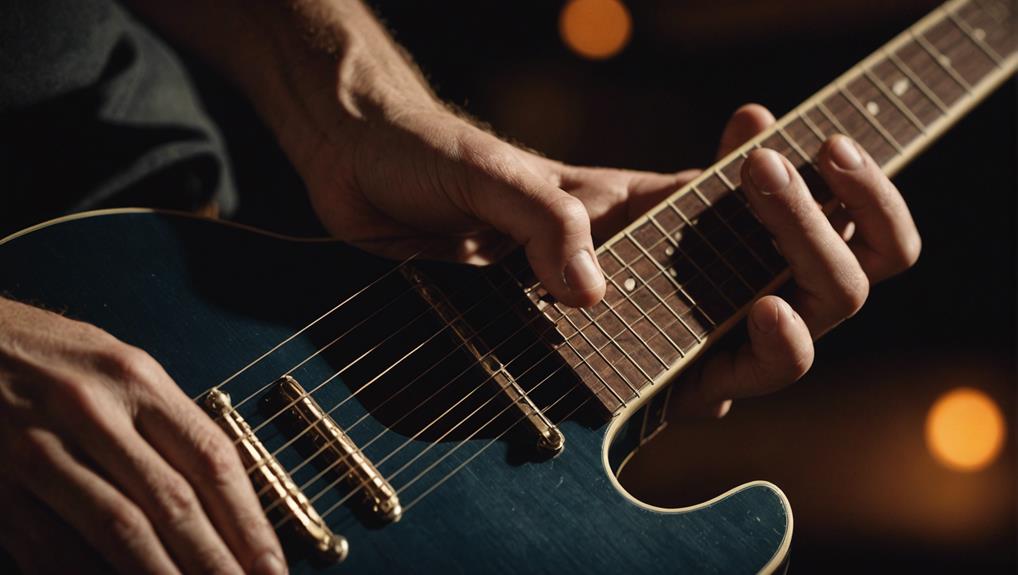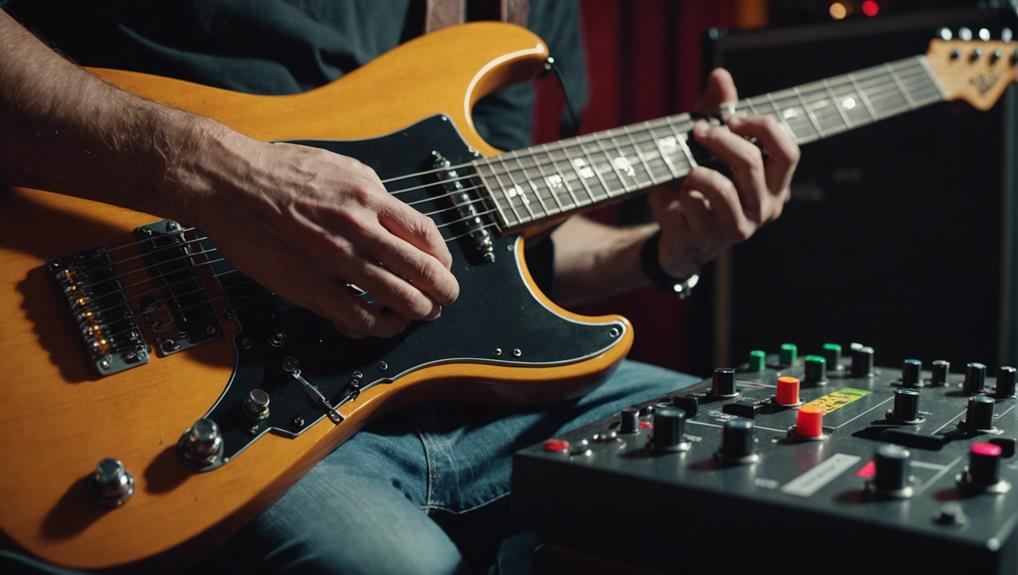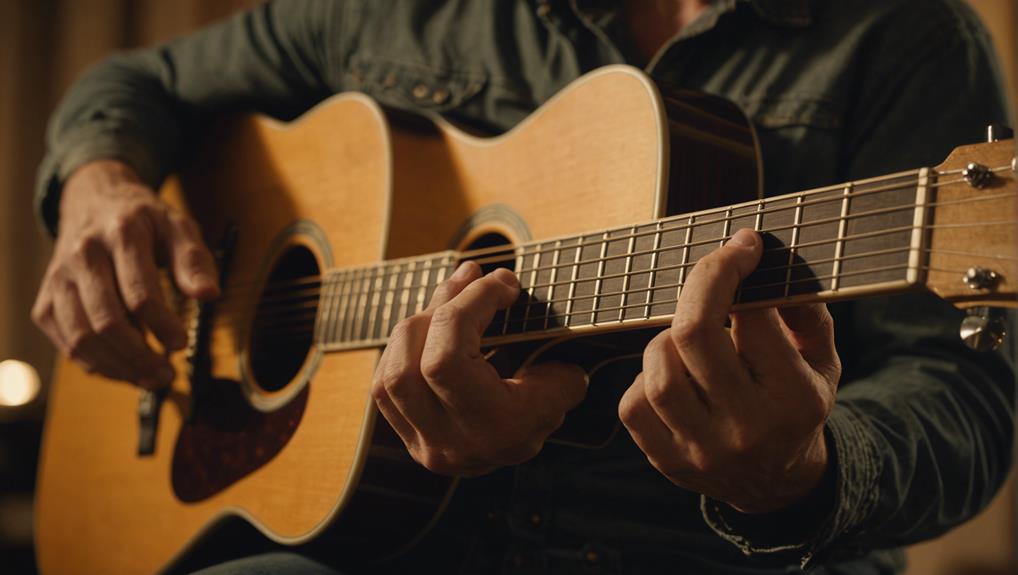As you start exploring guitar picking techniques, you’ll find they offer a myriad of ways to enrich your playing.
From the rapid notes of tremolo picking to the sharp tones of pinch harmonics, each technique brings its own flavor. Understanding pick slides and palm muting can transform your riffs, giving them a dynamic edge.
And if you’ve ever wondered how to blend pick precision with fingerstyle versatility, hybrid picking is the key.
Let’s take a closer look at these methods and discover how they can elevate your guitar expression.
TL-DR
- Tremolo Picking: Rapidly pick a single note for a fluttering, sustained effect, enhancing solos with intensity and speed.
- Pick Slides: Move the pick along the strings’ edge for a gritty texture, requiring thick picks and precise timing.
- Pinch Harmonics: Add high-pitched tones by focusing on thumb positioning and amplifier settings, enhancing rock and metal solos.
- Palm Mute: Rest the picking hand near the bridge to produce a tight, muted sound, adding a percussive effect to playing.
- Hybrid Picking: Combine pick precision with finger versatility for complex melodies and chords, popular in country, bluegrass, and jazz.
Tremolo Picking

Tremolo picking, often seen in rock and metal music, involves rapidly picking a single note or string to create a fluttering, sustained effect. This technique adds intensity and speed to your guitar solos, making them stand out with a powerful, driving sound.
To achieve a smooth and even tone, you need a consistent and controlled picking motion. It may seem challenging at first, especially if you’re new to the technique, but with practice, you’ll get the hang of it.
Start by focusing on your picking hand. Keep your movements small and precise to maintain control. Use a firm but relaxed grip on your pick, and try to avoid any unnecessary tension in your wrist and arm.
Practicing with a metronome can be incredibly beneficial. Set it to a slow tempo and gradually increase the speed as you become more comfortable with the motion. This helps improve your timing and accuracy, ensuring that each note is clear and evenly spaced.
Pick Slides
Pick slides add a gritty, aggressive texture to your playing by moving the pick along the strings’ edge. This technique is a staple in rock music and metal music, giving your riffs that extra punch.
To execute pick slides effectively, you’ll need durable picks, preferably thick ones, as they produce a clearer and more powerful sound.
When performing pick slides, you’re not just randomly dragging the pick. You need to control the movement to maintain consistent contact with the strings. Start by placing the edge of your pick against the string near the bridge, then slide it towards the neck. The friction creates that signature, aggressive sound, perfect for shifts or emphasizing specific notes in your solo or riff.
Mastering this technique requires precise timing. You have to synchronize the slide with the rhythm of the music, ensuring it lands exactly when you want it to. Practice is vital here; the more you do it, the better your control and timing will become.
Pinch Harmonics
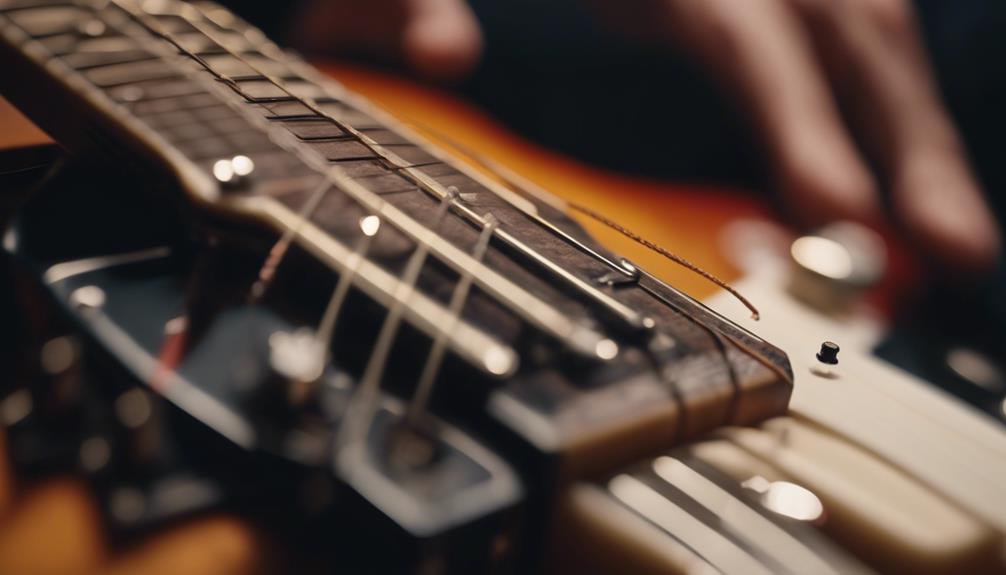
Now let’s tackle pinch harmonics, a technique that adds those squealing, high-pitched tones to your playing.
You’ll need to focus on proper thumb positioning and experiment with your amplifier and effects to get the best sound.
Mastering this requires precision, but the dynamic tones are worth the effort.
Achieving Squealing Harmonics
Mastering pinch harmonics, or squealing harmonics, involves precise timing and control to produce those distinctive high-pitched overtones that add depth to your guitar solos. This technique is essential in rock and metal genres, where those sharp, screaming notes can elevate your performance.
To achieve these sounds, you need to lightly touch the string with the side of your pick right after hitting it.
Here are some tips to help you master pinch harmonics:
- Use a small, thick pick: This type of pick makes it easier to control the technique and produce consistent results.
- Experiment with pick placement: Moving your pick along different parts of the string can yield various harmonic tones.
- Adjust picking intensity: The force you use can affect the clarity and volume of the harmonics.
- Practice with distortion: Harmonics are more pronounced and easier to hear with a bit of overdrive or distortion.
Proper Thumb Positioning
Proper thumb positioning is essential for executing pinch harmonics with precision and consistency. For ideal execution, place your thumb near the edge of the pick. This positioning enables easier pinching of the string while picking.
As you strike the string, let your thumb lightly touch it immediately after. This touch produces the harmonic overtone that creates the desired sound.
To master this technique, experiment with different thumb placements and pressures. Minor adjustments can greatly affect pitch control, allowing you to dial in the perfect squealing sound.
Don’t be afraid to tweak your approach until you find the sweet spot that works best for you.
Amplifier and Effects Usage
Achieving the perfect pinch harmonic isn’t just about technique; your amplifier and effects settings play a significant role in shaping the overall sound.
When dialing in your gear, you need to focus on the right combination of amplifier settings and effects pedals to bring out the rich, high-pitched squeal that defines pinch harmonics, especially in rock and metal genres.
First, consider your amplifier settings. A high gain setting is vital for producing the saturation needed to make pinch harmonics stand out. A little extra treble can also help accentuate the squeal.
Next, your choice of effects pedals can add layers of dynamics and tonal effects:
- Distortion/Overdrive: Essential for achieving the aggressive tone required in rock and metal.
- Compression: Helps sustain the harmonic, making it ring out longer and more clearly.
- EQ Pedal: Fine-tune frequencies to accentuate the harmonic squeals.
- Reverb/Delay: Adds depth and space, enhancing the overall sound.
Using small, thick picks can further enhance your control and ease of producing pinch harmonics.
With the right combination of technique and gear, you can add a signature sound to your playing, making your riffs and solos truly stand out.
Palm Mute
Palm muting involves resting the side of your picking hand near the bridge to produce a tight, muted sound. This technique is a staple in genres like rock, metal, and punk because it adds a percussive effect, making your playing sound more rhythmic and powerful.
To get started, place the fleshy part of your palm gently on the strings, right next to the bridge, and pluck the strings with your pick. You’ll notice the muted sound immediately.
The key to mastering palm muting is to adjust the pressure of your palm on the strings. More pressure will produce a tighter, more muted sound, while less pressure will allow more of the note to ring out. This control lets you vary the tones you produce, from barely muted to heavily choked.
Palm-muted riffs and power chords are essential elements of many songs in these genres. Experiment with different positions and pressures to find the sweet spot that gives you the sound you’re after. With practice, you’ll be able to seamlessly integrate palm muting into your playing, adding depth and complexity to your guitar work.
Downpicking
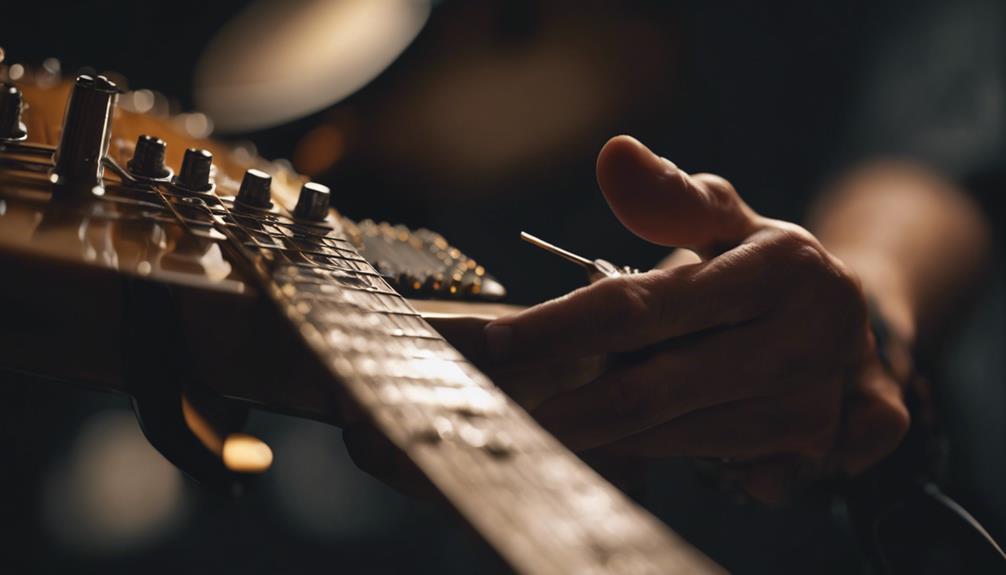
Downpicking, a dynamic technique favored in punk, hardcore, heavy metal, and thrash metal genres, delivers an aggressive and powerful sound by striking the strings downward. This technique emphasizes the downbeat, creating a commanding attack that sets these genres apart.
By focusing on downstrokes, you create a forceful approach that enhances the chugging power chords with palm muting, adding depth and intensity to your playing.
When you incorporate downpicking into your performance, you’re tapping into the raw and energetic essence that defines heavy and thrash metal. It’s a technique that requires dedication and stamina, but the payoff is an unmistakable, hard-hitting sound.
- Aggressive Sound: Downpicking emphasizes the downbeat, giving your music a punchy, aggressive edge.
- Chugging Power Chords: Combine downpicking with palm muting to produce those iconic, heavy chugs.
- Forceful Approach: This technique demands strength and precision, contributing to a powerful performance.
- Energetic Performance: Downpicking injects energy and intensity into your music, making your live shows unforgettable.
Mastering downpicking is essential if you’re seeking a heavy and impactful sound. With practice, you’ll be able to deliver the aggressive, high-energy performances that fans of heavy and thrash metal crave.
Hybrid Picking
Hybrid picking combines a pick and your fingers, giving you more tonal variety and flexibility.
You’ll find this technique useful for coordinating intricate melodies and complex arrangements.
It’s often used across different genres to add depth and expression to your playing.
Finger and Pick Coordination
When you master hybrid picking, you can combine the precision of a pick with the versatility of your fingers, enabling access to a wide array of tones and techniques. This approach, known as finger and pick coordination, greatly enhances your playing style. Hybrid picking offers incredible tonal variety and dexterity, making it a preferred technique in genres like country, bluegrass, jazz, and acoustic fingerstyle.
By incorporating hybrid picking, you can emulate the sounds of instruments like the banjo and pedal steel guitar. This technique allows you to execute intricate melodies, chords, and arpeggios with remarkable precision. Additionally, you can seamlessly switch between pick and finger playing, ensuring dynamic performances every time you play.
Here’s what you can achieve with hybrid picking:
- Enhanced tonal variety: Blend the sharpness of a pick with the warmth of finger plucking.
- Greater dexterity: Improve your finger independence and speed.
- Instrument emulation: Mimic the unique sounds of banjo and pedal steel guitar.
- Complex melodies: Effortlessly handle intricate melodies and chord progressions.
Mastering finger and pick coordination through hybrid picking opens up a world of dynamic and expressive musical possibilities.
Hybrid Picking Applications
Exploring hybrid picking in various genres lets you discover its potential to enhance your playing with unique tonal textures and intricate techniques. By combining pick and finger techniques, hybrid picking offers you versatile tonal options that many guitarists find indispensable. It’s particularly popular in country, bluegrass, and jazz, where intricate playing styles demand both speed and precision.
When you use hybrid picking, you can achieve simultaneous picking and plucking of strings. This technique allows you to maintain the aggressive attack of a pick while incorporating the subtler nuances of finger plucking. It’s an excellent way to enhance your speed and accuracy in complex melodic passages, making your playing sound more dynamic and expressive.
In country and bluegrass, hybrid picking helps you execute fast, intricate licks and banjo-like rolls. In jazz, it allows for more sophisticated chord voicings and melodic lines. You’re not limited to these genres, though; hybrid picking’s versatility can benefit any style of music.
Next up, learn about guitar strumming patterns in this guide.
